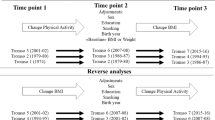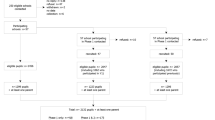Abstract
Objectives:
To examine the longitudinal relationship between occupational and domestic sources of physical activity and body weight in a sample of Chinese adults.
Methods:
Population-based longitudinal observational study of Chinese adults (4697 women and 4708 men) aged 18–55 from the 1991, 1993, 1997, and 2000 waves of the China Health and Nutrition Survey. Measured height and weight and detailed self-reported energy expenditure from multiple occupational and domestic sources were assessed over a 9-year period. Longitudinal relationships were modeled using linear random effects models.
Results:
Increased occupational physical activity resulted in overall lower body weight for both men and women (β-coefficients (95% confidence interval (CI)) for high levels: −0.46 (−0.76, −0.15) for men, −0.36 (−0.62, −0.10) for women, and increased domestic physical activity resulted in overall lower body weight in men (β-coefficient (95% CI): −0.40 (−0.62, −0.18)).
Conclusions:
Physical activity that occurs in the occupational and domestic sectors is often overlooked; yet our research suggests they have important effects on body weight in Chinese adults. As China continues to urbanize, energy expenditure from these sources is decreasing, and our results point out the need to explore these types of physical activity more broadly across the world as potential sources of weight gain.
This is a preview of subscription content, access via your institution
Access options
Subscribe to this journal
Receive 12 print issues and online access
$259.00 per year
only $21.58 per issue
Buy this article
- Purchase on Springer Link
- Instant access to full article PDF
Prices may be subject to local taxes which are calculated during checkout


Similar content being viewed by others
References
Ainsworth BE, Haskell WL, Whitt MC, Irwin ML, Swartz AM, Strath SJ et al. (2000). Compendium of physical activities: an update of activity codes and MET intensities. Med Sci Sports Exerc 32, S498–S504.
Ainsworth BE, Jacobs Jr DR, Leon AS, Richardson MT, Montoye HJ (1993). Assessment of the accuracy of physical activity questionnaire occupational data. J Occup Med 35, 1017–1027.
Ainsworth BE, Richardson MT, Jacobs Jr DR, Leon AS, Sternfeld B (1999). Accuracy of recall of occupational physical activity by questionnaire. J Clin Epidemiol 52, 219–227.
Baecke JA, Burema J, Frijters JE (1982). A short questionnaire for the measurement of habitual physical activity in epidemiological studies. Am J Clin Nutr 36, 936–942.
Ball K, Owen N, Salmon J, Bauman A, Gore CJ (2001). Associations of physical activity with body weight and fat in men and women. Int J Obes Relat Metab Disord 25, 914–919.
Barengo NC, Hu G, Lakka TA, Pekkarinen H, Nissinen A, Tuomilehto J (2004). Low physical activity as a predictor for total and cardiovascular disease mortality in middle-aged men and women in Finland. Eur Heart J 25, 2204–2211.
Bell AC, Ge K, Popkin BM (2001). Weight gain and its predictors in Chinese adults. Int J Obes 25, 1079–1086.
Buchowski MS, Townsend KM, Chen KY, Acra SA, Sun M (1999). Energy expenditure determined by self-reported physical activity is related to body fatness. Obes Res 7, 23–33.
Burton NW, Turrell G (2000). Occupation, hours worked, and leisure-time physical activity. Prevent Med 31, 673–681.
Caballero B (2001). Introduction. Symposium: obesity in developing countries: biological and ecological factors. J Nutr 131, 866S–8870.
Donahoe D (1999). Measuring women's work in developing countries. Popul Dev Rev 25, 543–576.
Du S, Lu B, Zhai F, Popkin BM (2002). A new stage of the nutrition transition in China. Public Health Nutr 5, 169–174.
Evenson KR, Rosamond WD, Cai J, Pereira MA, Ainsworth BE (2003). Occupational physical activity in the atherosclerosis risk in communities study. Ann Epidemiol 13, 351–357.
French SA, Story M, Jeffery RW (2001). Environmental influences on eating and physical activity. Annu Rev Public Health 22, 309–335.
Gutierrez-Fisac JL, Guallar-Castillon P, Diez-Ganan L, Lopez Garcia E, Banegas Banegas JR, Rodriguez Artalejo F (2002). Work-related physical activity is not associated with body mass index and obesity. Obes Res 10, 270–276.
Hill JO, Melanson EL (1999). Overview of the determinants of overweight and obesity: current evidence and research issues. Med Sci Sports Exerc 31, S515–S521.
Jacka T (1997). Women's Work in Rural China. Cambridge University Press: New York.
King GA, Fitzhugh EC, Bassett DR, McLaughlin JE, Strath SJ, Swartz AM et al. (2001). Relationship of leisure-time physical activity and occupational activity to the prevalence of obesity. Int J Obesity 25, 606–612.
Lakdawalla D, Philipson T (2002). The growth of obesity and technological change: a theoretical and empirical examination, NBER Working Paper no. 8946. National Bureau of Economic Research, Cambridge, MA.
Lanningham-Foster L, Nysse LJ, Levine JA (2003). Labor saved, calories lost: the energetic impact of domestic labor-saving devices. Obes Res 11, 1178–1181.
Lawlor DA, Taylor M, Bedford C, Ebrahim S (2002). Is housework good for health? Levels of physical activity and factors associated with activity in elderly women. Results from the British Women's Heart and Health Study. J Epidemiol Community Health 56, 473–478.
Lichtman SW, Pisarska K, Berman ER, Pestone M, Dowling H, Offenbacher E et al. (1992). Discrepancy between self-reported and actual caloric intake and exercise in obese subjects. New Engl J Med 327, 1893–1898.
Matthews CE (2002). Use of self-report instruments to assess physical activity. In: GJ Welk, (ed). Physical Activity Assessments for Health-Related Research. Human Kinetics Publishers, Inc.: Champaign, IL, pp 107–123.
McGuire J, Popkin BM (1989). Beating the zero-sum game: Women and nutrition in the third world. Part I. Food Nutr Bull 11, 38–63.
McGuire J, Popkin BM (1990). Beating the zero-sum game: women and nutrition in the third world. Part II. Food Nutr Bull 12, 3–11.
Mendez MA, Monteiro CA, Popkin BM (2005). Overweight exceeds underweight among women in most developing countries. Am J Clin Nutr 81, 714–721.
Monda KL, Gordon-Larsen P, Stevens J, Popkin BM (2007). China's transition: the effect of rapid urbanization on adult occupational physical activity. Soc Sci Med 64, 858–870.
Mummery WK, Schofield GM, Steele R, Eakin EG, Brown WJ (2005). Occupational sitting time and overweight and obesity in Australian workers. Am J Prev Med 29, 91–97.
Paeratakul S, Popkin BM, Ge K, Adair LS, Stevens J (1998). Changes in diet and physical activity affect the BMI of Chinese adults. Int J Obes 22, 424–431.
Pate RR, Pratt M, Blair SN, Haskell WL, Macera CA, Bouchard C et al. (1995). Physical activity and public health. A recommendation from the Centers for Disease Control and Prevention and the American College of Sports Medicine. JAMA 273, 402–407.
Philippaerts RM, Lefevre J (1998). Reliability and validity of three physical activity questionnaires in Flemish males. Am J Epidemiol 147, 982–990.
Philipson TJ, Posner RA (2003). The long-run growth in obesity as a function of technological change. Perspect Biol Med 46, S87–S107.
Phongsavan P, Merom D, Marshall A, Bauman A (2004). Estimating physical activity level: the role of domestic activities. J Epidemiol Community Health 58, 466–467.
Popkin BM (1999). Urbanization, lifestyle changes and the nutrition transition. World Dev 27, 1905–1916.
Popkin BM (2003). Dynamics of the nutrition transition and its implications for the developing world. Forum Nutr 56, 262–264.
Popkin BM (2006). Global nutrition dynamics: the world is shifting rapidly toward a diet linked with noncommunicable diseases. Am J Clin Nutr 84, 289–298.
Popkin BM, Conde W, Hou N, Monteiro C (2006). Is there a lag globally in overweight trends for children compared with adults? Obesity (Silver Spring) 14, 1846–1853.
Reis JP, Dubose KD, Ainsworth BE, Macera CA, Yore MM (2005). Reliability and validity of the occupational physical activity questionnaire. Med Sci Sports Exerc 37, 2075–2083.
Salmon J, Owen N, Bauman A, Schmitz MK, Booth M (2000). Leisure-time, occupational, and household physical activity among professional, skilled, and less-skilled workers and homemakers. Prev Med 30, 191–199.
Short S, Chen F, Entwisle B, Fengying Z (2002). Maternal work and child care in China: a multi-method analysis. Popul Dev Rev 28, 31–57.
Sobel ME (1982). Asymptotic confidence intervals for indirect effects in structural equation models. In: S Leinhardt (ed). Sociological Methodology. American Sociological Association: Washington DC, pp 290–312.
Stookey JD, Adair L, Stevens J, Popkin BM (2001). Patterns of long-term change in body composition are associated with diet, activity, income and urban residence among older adults in China. J Nutr 131, 2433S–2440S.
Vaz M, Bharathi AV (2004). How sedentary are people in ‘sedentary’ occupations? The physical activity of teachers in urban South India. Occup Med (Lond) 54, 369–372.
Weller I, Corey P (1998). The impact of excluding non-leisure energy expenditure on the relation between physical activity and mortality in women. Epidemiology 9, 632–635.
WHO/FAO (2003). Expert consultation on diet, nutrition and the prevention of chronic diseases. Report of the joint WHO/FAO expert consultation. WHO Technical Report Series, No. 916 (TRS 916). World Health Organization, Geneva.
Xu X, Niu T, Christiani DC, Weiss ST, Zhou Y, Chen C et al. (1997). Environmental and occupational determinants of blood pressure in rural communities in China. Ann Epidemiol 7, 95–106.
Yao M, McCrory MA, Ma G, Tucker KL, Gao S, Fuss P et al. (2003). Relative influence of diet and physical activity on body composition in urban Chinese adults. Am J Clin Nutr 77, 1409–1416.
Zhou B, Li Y, Stamler J, Tao S, Davis CE, Wu Y et al. (2003). Relation of occupational change to cardiovascular risk factor levels in rural Chinese men: the People's Republic of China-United States Collaborative Study on Cardiovascular and Cardiopulmonary Epidemiology. Am J Public Health 93, 2049–2051.
Acknowledgements
Financial assistance for this research has come from the US National Institutes of Health (NIH) (RO1-HD30880 and R01-HD38700). We thank Ms Frances L Dancy for her administrative assistance, Jim Terry for programming support, Tom Swasey for his work on the graphics, and David Guilkey for statistical and methodological advice.
Author information
Authors and Affiliations
Corresponding author
Rights and permissions
About this article
Cite this article
Monda, K., Adair, L., Zhai, F. et al. Longitudinal relationships between occupational and domestic physical activity patterns and body weight in China. Eur J Clin Nutr 62, 1318–1325 (2008). https://doi.org/10.1038/sj.ejcn.1602849
Received:
Revised:
Accepted:
Published:
Issue Date:
DOI: https://doi.org/10.1038/sj.ejcn.1602849
Keywords
This article is cited by
-
The built environment, purpose-specific walking behaviour and overweight: evidence from Wuhan metropolis in central China
International Journal of Health Geographics (2024)
-
Analysis of the spatial patterns of malnutrition among women in Nigeria with a Bayesian structured additive model
GeoJournal (2020)
-
Association of changes in commute mode with body mass index and visceral adiposity: a longitudinal study
International Journal of Behavioral Nutrition and Physical Activity (2019)
-
Rising rural body-mass index is the main driver of the global obesity epidemic in adults
Nature (2019)
-
Socioeconomic disparities in abdominal obesity over the life course in China
International Journal for Equity in Health (2018)



